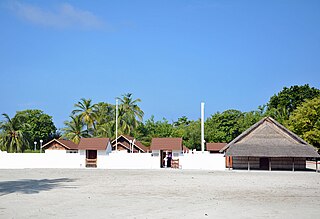
Maldives, officially the Republic of Maldives, is an archipelagic state in South Asia, situated in the Indian Ocean. It lies southwest of Sri Lanka and India, about 750 kilometres from the Asian continent's mainland. Maldives' chain of 26 atolls stretches across the equator from Ihavandhippolhu Atoll in the north to Addu Atoll in the south.

Malé is the capital and most populous city of the Maldives. With a population of 252,768 and an area of 8.30 square kilometres (3.20 sq mi), it is also one of the most densely populated cities in the world. The city is geographically located at the southern edge of North Malé Atoll. Administratively, the city consists of a central island, an airport island, and four other islands governed by the Malé City Council.

Fuvahmulah is an island (atoll) in the Maldives. It is under Maldives’ administrative divisions of Gnaviyani Atoll or Nyaviyani Atoll. The inhabitants speak a distinctive form of the Dhivehi language, locally known as "fuvahmulaki baha.”
Vaadhoo is an inhabited island of Gaafu Dhaalu region in the atoll of Huvadhu, Maldives. It has its own dialect of Maldivian, which is considerably different from northern and Mid-Maldivian speech.
Fonadhoo is the capital island in Laamu atoll of the Maldives.

Meedhoo is one of the inhabited islands of Dhaalu Atoll.

Mahibadhoo is an island town in central Maldives, and is the capital of South Ari Atoll.

Naifaru is an island in the Maldives 141 km (88 mi) north of the capital, Malé. It is the capital and most populous island of Lhaviyani Atoll.

Dharavandhoo is one of the inhabited islands of Baa Atoll.
Kendhoo is one of the inhabited islands of Baa Atoll, Maldives. It is located in the northern part of the Baa Atoll.
Maakurathu is one of the inhabited islands of Raa Atoll in the Maldives. Sultan Mohamed I is from Maakurathu. He is also the husband of Sultana Raadhafathi.

Maroshi is one of the inhabited islands of the Shaviyani Atoll administrative division and geographically part of the Miladhummadulhu Atoll in the Maldives.
Noomaraa is one of the inhabited islands of the Shaviyani Atoll administrative division, and geographically part of the North Miladhummadulhu Atoll in the Maldives. The Island code is C2.
Vaikaradhoo is one of the inhabited islands of Haa Dhaalu Atoll administrative division of the Maldives.
Baarah is an inhabited island in Haa Alif Atoll in the northern Maldives. It is an island-level administrative constituency governed by the Baarah Island Council.
Thakandhoo is one of the inhabited islands of Haa Alif Atoll administrative division and is geographically part of Thiladhummathi Atoll in the north of the Maldives. It is an island-level administrative constituency governed by the Thakandhoo Island Council.

Utheemu is one of the inhabited islands of Haa Alif Atoll administrative division and geographically part of Thiladhummathi Atoll in the north of the Maldives. It is an island-level administrative constituency governed by the Utheemu Island Council.

Hulhumeedhoo or Hulhudhoo-Meedhoo is an island located on the northeastern point of Addu City. It is the fifth largest island in the Maldives. Although Hulhumeedhoo is geographically one island, it is divided into two administrative constituencies of Addu City, known as Meedhoo and Hulhudhoo, which are roughly the northern half and southern half of Hulhumeedhoo respectively. The name "Hulhumeedhoo" is an amalgamation of the names Hulhudhoo and Meedhoo.
Nilandhoo is the capital of Faafu Atoll, a region with five inhabited islands. It is the largest and most populated island in the region, and includes historical sites such as foah'mathi and Aasaari Miskiy and a school. Foah'mathi is a historical site with a Buddhist temple under it, while Aasaari Miskiy is the second mosque built in the Maldives.
Dhuvaafaru is an inhabited island of Maldives located in the eastern edge of Raa Atoll. Resettlement of the island started on 14 December 2008 to inhabit the displaced residents of Kandholhudhoo who were the victims of the 2004 Indian Ocean earthquake and tsunami.










